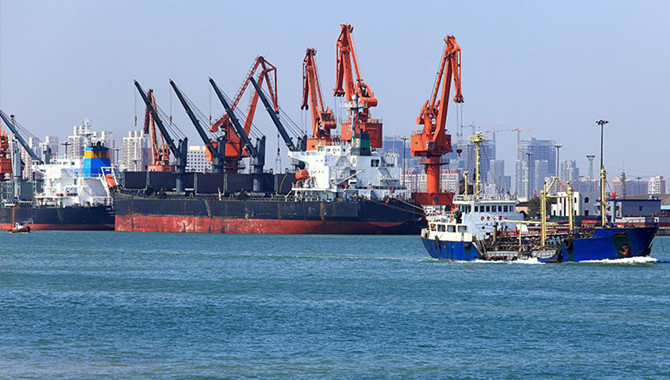
The Ministry of Natural Resources said Wednesday that China's gross ocean product rose 1.2 percent to over 4.2 trillion yuan (about 622 billion U.S. dollars) in the first half of 2022, with the major economic indicators maintaining in a reasonable range, featuring an ensured recovery of the marine economy and a highlighted low carbon development.
From January to June this year, the country has seen a recovery trend of the traditional marine industry.
The output of offshore crude oil and natural gas increased by 7.4 percent and 12.4 percent year on year, respectively, after some of the oilfield projects have been put into production gradually.
Wind power generation in coastal areas climbed nearly 20 per cent year on year.
In the first half of this year, the cargo and container throughput at coastal ports both registered an increase, with the marine transportation volume up 1.4 percent year on year.
China maintained its top position in the global shipbuilding industry in the first half of the year by the three major indexes of the sector, namely the completion volume, new order volume and holding order volume.
"In the first half of this year, 57.7 percent of the surveyed enterprises in the emerging marine industries achieved year-on-year growth in operating revenue. The orders of container ships and gas ships accounted for more than half of the total, and the scale of newly undertaken orders of liquefied natural gas (LNG) carriers hit an ever new high," said Cui Xiaojian, deputy director of National Marine Data and Information Service (NMDIS) under the Ministry of Natural Resources.
Meanwhile, foreign trade through ocean shipping also reported a robust growth of 18.2 percent year on year, with the import and export up 11.5 percent and 23.1 percent, respectively. Among those, the import and export of aquatic products increased by 22.3 percent compared with the same period of last year.
With the active efforts made by the government, operation and production of enterprises in the sector got recovery momentum as the country has effectively curbed the COVID-29 resurgences, which have caused bitter economic downward pressure nationwide. Besides, the industry has been seeing increasing interest in green and low-carbon development.
During this period, the application of clean energy has been accelerated.
North China's Hebei Province has sent a wind farm and photovoltaic power station with a total installed capacity of 186 million kilowatts to the Bohai Sea through an oilfield shore power project.
Tianjin Port in northern part of China has installed a set of shore power equipment with an output of 8 megavolt, which can meet the power demand of six berths.
Dalian has initiated the construction of the country's largest sea cucumber farming demonstration park supported by photovoltaic power, a marine ranch projected based on offshore wind power plant, and other innovation projects.
"It's the first time for the Bohai oil field to use green power, and the coastal ports also sped up pace to construct shore power systems. The fishery supported by clean energy has become a new development trend," said Cui.
Also, infrastructure of the marine industries embraced upgrade and transform in the first six months. China's first intelligent manufacturing base for offshore oil and gas production equipment has been put into operation in Tianjin. The country's first intelligent deep-sea oil and gas storage center started operation in southern China's Hainan Province.
China will promote the development and application of low-carbon technologies and set up green manufacturing systems, so as to reach its carbon-neutral goal of having the CO2 emissions peak before 2030 and achieving the carbon neutrality before 2060.
Source: CCTV
The opinions expressed herein are the author's and not necessarily those of The Xinde Marine News.
Please Contact Us at:
media@xindemarine.com


 Ningbo Containerized Freight Index Weekly Commentar
Ningbo Containerized Freight Index Weekly Commentar  Ningbo Containerized Freight Index Weekly Commentar
Ningbo Containerized Freight Index Weekly Commentar  Ningbo Containerized Freight Index Weekly Commentar
Ningbo Containerized Freight Index Weekly Commentar  BIMCO Shipping Number of the Week: Bulker newbuildi
BIMCO Shipping Number of the Week: Bulker newbuildi  Ningbo Containerized Freight Index Weekly Commentar
Ningbo Containerized Freight Index Weekly Commentar  Ningbo Containerized Freight Index Weekly Commentar
Ningbo Containerized Freight Index Weekly Commentar